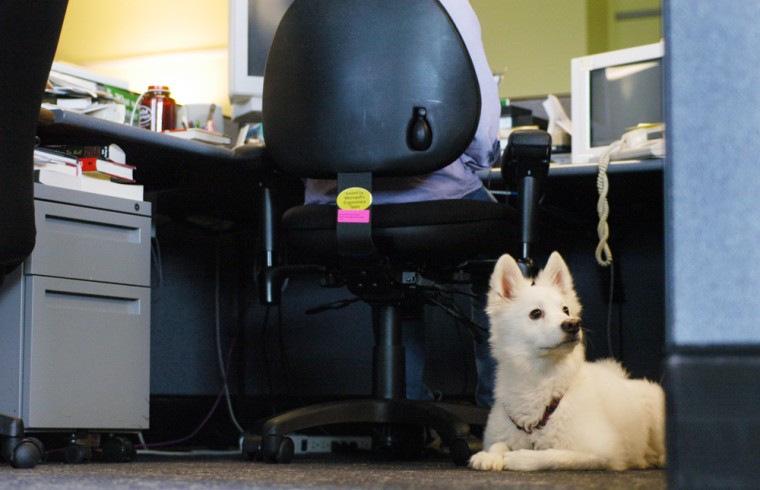Each day, millions of Americans head for work, leaving their canine companions behind. But one group hopes that at least once a year, every dog has its day — in the office.
Pet Sitters International, sponsor of Take Your Dog to Work Day, estimates that as many as 10,000 companies in the United States and Canada opened their doors to employees' dogs during the annual event held last June.
The event was designed to let employees demonstrate the value of their four-legged friends, and encourage those without pets to adopt from shelters, rescue groups and humane societies.
It’s also the perfect event to test future dog policies out "and a great way to showcase how pets can fit in,” said John Long, public relations coordinator for Pet Sitters International.
Growing trend
According to the U.S. Humane Society, there are 65 million dogs in 39 percent of American households. Although they offer no figures, advocates say that allowing pets in the workplace is a growing trend because their presence can be beneficial to the company as well as employees and animals.
Slideshow 22 photos
Animal Tracks: Aug. 4 - Aug. 11
“It was very popular in the late '90s,” said Len Kain, co-founder of Dogfriendly.com, which publishes pet travel guides. “It kind of died down after the tech industry bust, but now it’s coming back.”
Kain said that more companies are looking into dog-friendly policies because they improve staff morale and camaraderie and encourage employees to work longer hours. “People will stay longer if they don’t have to leave to let their dog out,” he said.
Medium to smaller businesses are most receptive to allowing dogs at work, Kain said: "The less people in the office space, the easier it is to reach consensus on a workplace policy. Many of the larger corporations have a lot of legal issues, insurance regulations, that sort of thing."
Golden Lasso, an advertising and design agency in Seattle, fits that profile.
“I know that for me, having dogs at work seriously reduces my stress level," said employee Amanda Williams. "It really puts things into perspective to be all freaked out about some project and to look down and see a dog smiling at you.”
Don't herd the employees
Then there are the pitfalls.
“I used to have a client with two dogs in the office," said a Seattle-area networking consulting who spoke on condition of anonymity. "Whenever I called on them, both dogs would rush out barking. … One was an Australian shepherd that had ‘dominance issues,’ as his owner describes. It would try to herd me around the office by nipping at my pant cuffs, and on several occasions biting my leg to get me moving.
"A couple of times I remember seeing clients or vendors become frightened by the two dogs rushing at them.”
Kain said companies with strict policies have the most success with dogs at work. Two rules of thumb: The owner must be in control of the dog and the animal must be leashed and out of the way, especially from people who are uncomfortable or afraid of dogs, he said.
Allergies and accidents
The most common problem in with dogs in the workplace is allergies.
“If you look at the general population, 20 to 30 percent of adults have animal allergies, and 3.5 percent of adults have asthma," Dr. Jonathan Corren, assistant clinical professor of medicine at UCLA. "One percent can have an event triggered by allergic reaction, and one in 10 people could be made uncomfortable.”
But Corren added that if dogs aren’t around constantly, distance is helpful. “A dog won’t leave a whole lot of allergens if it’s there for just a few hours. If someone moves, say, 100 feet away, it would probably fix the problem,” he said.
And, of course, there’s always the possibility of potty accidents. “Owners know their dogs best. They know if their pets can behave properly,” Long said. “In the end, common sense rules the day.”
A less obvious problem can be becoming too attached to an animal. When Williams lost her first dog, she had a difficult time going to work without him.
“Usually, in times of crisis, I can dive into work and escape whatever is going on with me," she said. "After bringing him to work with me every day since he was 7 weeks old, returning to work after his death was no escape.
"I missed a lot of work. When I returned it was just as hard if not harder than being at home, not to mention the effect it had on the office as they had seen him grow up.”
Some guidelines
For a pleasant workplace experience, here are some tips from Dogfriendly.com:
- Dogs must be tied to a standard six-foot leash or in a closed office or cubicle. Some employees will put a small folding fence, or baby gate, in front of their cubicle door so their pup cannot roam around.
- Dogs that are aggressive toward people should not be taken to work.
- They must be flea-free.
- "Three accidents and you're out": Some companies require dogs to stay home if they go to the bathroom more than twice at work.

